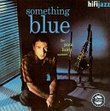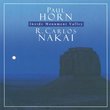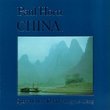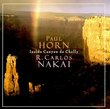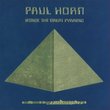| All Artists: Paul Horn Title: Inside The Taj Mahal I & II Members Wishing: 2 Total Copies: 0 Label: Inside Music Inc. Original Release Date: 1/1/2008 Re-Release Date: 6/17/2008 Genres: New Age, Pop Style: Meditation Number of Discs: 1 SwapaCD Credits: 1 UPC: 777005000822 |
Search - Paul Horn :: Inside The Taj Mahal I & II
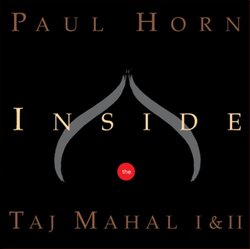 | Paul Horn Inside The Taj Mahal I & II Genres: New Age, Pop
Five-time Grammy-nominated jazz flutist/saxophonist Paul Horn is a founding father of world and New Age music, and this disc features two of the most popular titles in the genres. Inside the Taj Mahal I was recorded ins... more » |
Larger Image |
CD DetailsSynopsis
Amazon.com Five-time Grammy-nominated jazz flutist/saxophonist Paul Horn is a founding father of world and New Age music, and this disc features two of the most popular titles in the genres. Inside the Taj Mahal I was recorded inside the impressive and enigmatic world wonder in 1968, and Horn's fluid flute and snaky soprano sax lines resonate with a spectral spiritual reverb and echo that reaches right into the human soul. Horn's tantric tones are augmented by ancient Hindu-inspired chants on "Jumna," "Mumtaz Mahal," and "Vibrations." His follow-up, Inside the Taj Mahal II, was recorded in 1988 and expands the sonic spirituality of the first recording. The "Taj Mahal Suite," a 17-part work, features more jazz-like improvisations bathed in India's millennia-old traditions. With these projects, Horn put Indian music out of the realm of the musical anthropologist and into the minds and hearts of millions of music lovers around the world. --Eugene Holley, Jr. Similar CDs
|
CD ReviewsPure and Stunning. It will transport you. 04/10/2001 (5 out of 5 stars) "I had heard of Paul Horn but was unaware of his focus, his seminal works recorded some ten years before I stumbled on improvisational 'New Age' music. This recording, to me, bewitches; one is swept into the mystery of this Indian shrine by a single note that pierces the silence and ascends,carrying one with it. Yes, this is deeply mediative music. This is not New Age quazi-jazz aural wallpaper. Horn weaves an exquisite sense of place and history with a creation of pure, playful and reverent sound. His flute and sax, with the prayer songs interspersed, tell a wordless story that, to me, feeds a place I didn't know was empty. This music is singular, powerful, transporting. Ahem! Rather than babble on: think of how different Keith Jarrett is from George Winston, cognac from zinfandel. I heard cuts of this on NPR while driving and had to pull over. This music is not kid stuff. Listen to any cuts of it posted here and let it seep in. Is this how Orpheus sounded? The next step in journey?" Paul Horn review Dr. James L. Fabert, DD, PhD | Clarkdale, AZ | 06/09/2001 (5 out of 5 stars) "As a spiritual teacher of study and meditation practices, I have reviewed almost every "tool" available to me as a teacher. In my professional opinion, Paul Horn produces the finest meditation music to be found anywhere. Tone and sound is very important to my practice. His Inside series, particularly "Inside the Great Pyramid of Giza", is the best I have heard thus far. There are none finer than Paul. My highest recommendation. Dr. James L. Fabert, DD, PhD" Nothing short of amazing BENJAMIN MILER | Veneta, Oregon | 12/28/2002 (5 out of 5 stars) "I'm the type of person who usually doesn't go for New Age or world music. Especially the fact New Age music had became really tacky in the 1980s and 1990s, and the likes of John Tesh and Yanni became big names in that field of music. But Paul Horn's Inside the Taj Mahal isn't like that. Paul Horn had a really drastic change in musical styles by the late 1960s. Prior to circa 1967, he was playing conventional jazz since the 1950s. By the end of 1966, he was in India studying meditation with the Maharishi Mahesh Yogi (same guy the Beatles studied meditation with). He was becoming increasingly dissatisfied with western conventions, so he decided get inspiration from Eastern philosphy, religion, and meditation. A couple of trips to India later, in the middle of making a documentary that never finished, Paul Horn stopped by the Taj Mahal in April 1968 and recorded the original Inside the Taj Mahal. The album first surfaced on Epic Records, entitled simply Inside. The results is some really stunning flute music recorded in the famous Indian monument. The music has the relaxing, meditative mood, helped on by the sustained echo the Taj Mahal provided. And while it's mostly flute being used, vocals are provided from time to time. As for Inside the Taj Mahal II, well this was a 1988 recording to commemorate the 20th anniversary of the original recording, only this time around, he was able to get a hold of digital equipment (technology that was common knowledge in 1988, but did not exist in 1968) as well as several different flutes and saxes. Inside the Taj Mahal II is not the album he released in 1972 called Inside II (that was a totally different album). Regardless, Inside the Taj Mahal is quite an interesting album if like meditative flute music."
|

 Track Listings (25) - Disc #1
Track Listings (25) - Disc #1